[Retracted] Application Research of Wireless Sensor Network Based on Computer BIM Technology and ZigBee in Interior Art Design
Abstract
With the rapid development of computer technology and automation technology, modern interior art design has attracted more and more attention. This paper chooses BIM technology and ZigBee technology, which have the advantages of low cost, low power consumption, low complexity, etc., and can be used to establish the communication protocol of indoor art design and home wireless network, so as to achieve residential comfort and wireless data security transmission and convenient, real-time monitoring. This paper starts with many environmental parameters that are closely related to human comfort, such as temperature and humidity, light, and air cleanliness, and conducts an investigation on the comfort of intelligent houses and the appreciation of modern indoor art; this paper discusses the security of BIM and ZigBee and the algorithm of AES starting from the specific implementation process; according to the internal characteristics and password requirements of the family, a smart home safety net is constructed and encrypted, so as to ensure the safe transmission of family information; complete the modern artistic design of the home controller. The hardware and software were constructed, and a web server was constructed on Linux, which was invoked using the CGI interface, thereby connecting the web server to the terminal device that was comfortably controlled. The test proves that the control scheme can work normally in the laboratory network, which has great guiding significance for practical work.
1. Introduction
Smart home is also known as home automation, digital home, home network, and many more. Its specific content is as follows: smart house is based on the broadband network in the community, and a set of household-based system management system is established through indoor network conditions, aiming to provide services for residents’ living system, structure, service, management, etc., to create a comfortable, safe, and convenient living space for users [1]. The relevant theories about smart home at home and abroad began in the 1970s, and most of the current research is mainly in developed countries [2]. The world’s first intelligent building was built in Connecticut, USA. At that time, it only made some modifications to an old building, through computer monitoring and monitoring of the building’s air conditioning, elevators, and lighting equipment, as well as voice communication, e-mail, intelligence, etc. [3]. With the development of communication and information technology today, a set of bus-based commercial communication equipment, home appliances, and security equipment has been proposed. The more mature regions such as the United States and Southeast Asia have also successively launched different smart housing designs, and in the United States, Japan, Singapore, and other places, there are also smart housing developments [4]. However, because each country has conducted relatively little research on it, its research and development purposes and marketing strategies are not the same, so there is no unified standard in China.
China’s interior art design urgently needs BIM technology. BIM technology has realized the operation of an integrated design platform from architecture to interior art design, material construction, etc., and it will also become an inevitable trend of interior art design reform. As the core competitiveness of the development of the decoration industry, BIM technology promotes the innovation of building decoration technology, and more and more companies are beginning to study how BIM technology can be applied to interior art design. At present, the research of BIM technology has achieved certain results, but the application of BIM+ ZigBee technology to the development and application of interior art design is less. If BIM+ ZigBee design is connected to interior art design, it should have high application value for the development of interior art design.
Compared with foreign countries, the development of domestic smart home and interior art design is relatively lagging behind [5]. Most of them have introduced foreign technologies and have not yet formed a complete specification, but various manufacturers have developed their own smart homes, such as Tsinghua University Tongfang Company’s electronic home digital home, Haier’s “ejiajia,” Kelon company’s “Modern Family Information Management Center,” and so on [6]. The “Home Network Platform” (i.e., the e-home system) and “Information Equipment Resource Sharing and Collaborative Services” (i.e., the top ten editions) issued by the Ministry of Information Industry have become one of the nationally recommended industry standards. At the security exhibition in Shenzhen, many manufacturers of door control equipment exhibited their “smart home products,” such as “Bticino” and “Fujian Guanlin” from Victor Legrand, “Smart Home Terminal” series products, “HS360 Information Machine” of Kejia Company, “Juyi Smart Home” of Xiamen Zhenwei Company, and so on. At the “China” public security exhibition in Beijing, China, the concept of smart home is no longer limited to the concept of one or a few companies, but more pushed to the entire smart home field. In recent years, Chinese enterprises have successively launched intelligent homes that meet actual needs, and integrators, developers, and decoration companies have rich practical experience [7–10]. Therefore, how to build high-efficiency and low-cost housing has become a research topic in today’s world. In the home network, two ways of wired and wireless realize the internal networking of the home [11]. Compared with wired networking, wireless networking not only saves the cost and manpower of total wiring but also has flexibility, which is more suitable for the characteristics of home network communication [12]. With the continuous development of wireless technology, its development will inevitably have a huge impetus to its widespread use in the home.
The research content of this paper includes the following: based on BIM technology, embedded technology, ZigBee technology, network technology, and many other technologies and research on its overall planning and architecture. This study mainly adjusts various parameters related to human comfort and indoor art design viewing, such as temperature and humidity, light, and air cleanliness, in order to achieve the comfort level of the house.
2. The Overall Scheme of the Interior Design System
This paper uses BIM + ZigBee technology to realize the art and comfort design based on the indoor four-dimensional space, including indoor environment, furnishings, and decoration.
2.1. BIM Technology Collaborative Design and Related Modification
BIM is a complete, large-scale computer-based document that integrates various professional design materials into a project [13, 14]. At the same time, the collaboration between various disciplines will also upload the design data to various systems in real time and integrate them into one system. If you want to change some details of the interior space, you only need to change the model a little bit. This method cannot reduce the number of revisions but can greatly improve the efficiency of revisions. For example, in the floor plan of the interior space on the first floor, as long as the relevant riser parameter information is adjusted on the floor plan, the system will generate new floor plans, elevations, node details, and sections.
BIM technology has been applied in the internal art design of various majors, so when the main document of the project is compiled, the work can be arranged according to its own work experience [15]. In the internal space, the collaborative design between various disciplines is based on the platform, which timely updates the feedback information in a timely manner, and uses a complete connection mode to share information [16]. Once a model is established, all relevant documents are promptly fed back to the user, ensuring that design information for each discipline is properly transmitted and displayed. BIM-based interior design is shown in Figure 1.
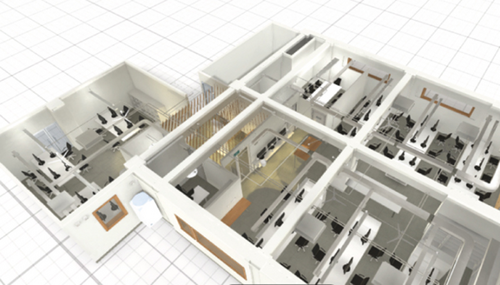
2.2. Internal Network Topology Selection
There are three network modes of ZigBee: star network, tree network, and mesh network [17]. In a smart house, the communication interval of each node is relatively close, and there is no need to use a router to expand the coverage. At the same time, the location and number of home appliances are also easily changed. Therefore, in a smart house system, most of the information is transmitted in the main controller with other endpoints. According to the characteristics of home intelligence, a star topology is used to design the home wireless network.
2.2.1. System Function Module Division
According to the analysis of smart home function requirements, we can divide the internal network of the smart home system into five modules, namely, comfort control module, electrical control module, fire alarm module, security access control module, and three-meter equipment module, as shown in Figure 2. Each module contains control submodules that realize their respective functions, and the control submodule is the ZigBee terminal node. Each terminal node exchanges data with the main controller of the smart home according to the requirements of the system and accepts the control commands of the main controller.
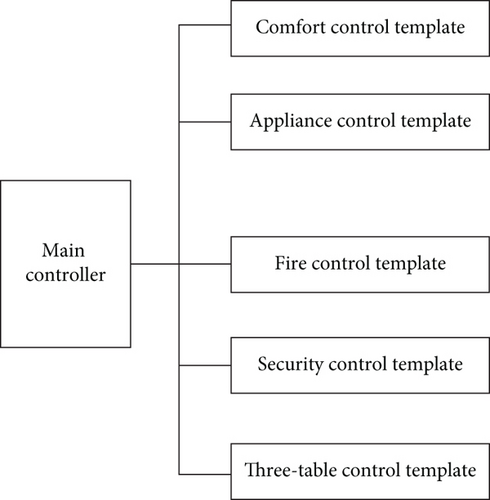
In the current interior design, technologies such as electrical control, fire alarm, access control, and three-instrument control are relatively complete, and a trend of commercialization and application has gradually formed. It is also a new topic that has just emerged in recent years. Many technologies still need to be improved and upgraded. In the future development trend, modern art design houses with comfortable control modules will occupy an important position in future families. Therefore, compared with other control units, the control application of comfort and viewing is more important. This article mainly focuses on indoor comfort and viewing and makes a detailed analysis from the aspects of temperature and humidity, light, air cleanliness, etc., in order to achieve the purpose of comfort and beauty.
2.3. Indoor Environment Control
2.3.1. Implementation of Temperature and Humidity Control
The temperature and humidity control node designed in this paper is mainly composed of five parts: wireless transceiver module CC2430, temperature and humidity data acquisition module, infrared transmitter module, power supply module, and debugging interface. The structure diagram is shown in Figure 3. The control of temperature and humidity mainly includes the collection of information such as temperature and humidity, and then, the information is transmitted to the main controller by the internal wireless network, the information received by the host is processed and compared, and finally, the appropriate control algorithm is calculated by the fuzzy control algorithm value and then transmits the control value to the temperature and humidity control point, and then, the control point transmits the control command.
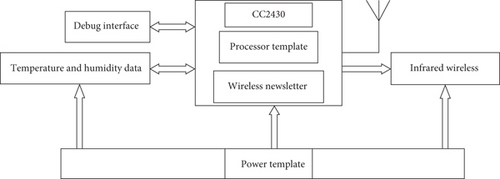
2.3.2. Implementation of Light Control
The lighting control device can realize fully automatic operation. According to different time periods, different situations such as daytime, dinner, and night are set, so as to automatically display different pictures within a certain period of time. Convert to different screens and perform corresponding operations, as shown in Figure 4.
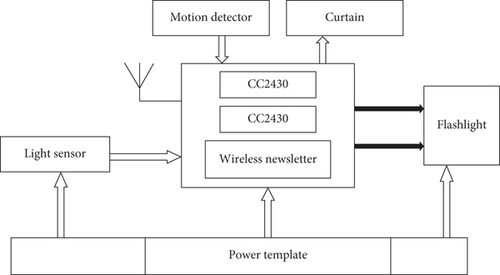
In the daytime, the light sensor collects the light data in the room, and the motion detector determines whether there is anyone in the room. The light control point will transmit the light and motion detection information to the main console, and the main console will detect according to the movement information to determine whether there is a person in the room, and then compare the collected light information with the user’s preferences. If it is raining or the size of the curtains cannot be adjusted to meet the user’s preference, the system will send out corresponding lighting adjustment commands according to the indoor lighting conditions to adjust the lighting in the room. During the meal, the main control system will issue appropriate instructions to turn off and light on according to the lighting conditions of the room, creating a soft and comfortable lighting environment, allowing users to fully relax and rest. At night, the main control system will issue an instruction to close the curtains, and at the same time, the information of lighting and motion detection will be fed back to the main control system. Nodes issue lighting commands so that the room can be lit and automatically turned off. When the user wants to sleep, he can manually turn off the light in the active area, so that the light in the room changes from bright to dim, and then turn on a small light, which will disappear after a minute, so that the user does not have to touch it in the dark. In addition, the system can also design various special scenes for users, such as parties and home theater scenes. Different scenes have different preset lights, and users can adjust them according to their own preferences.
The whole system is personalized and can be adjusted according to the user’s needs. At the same time, natural light is used rationally, and the lights are automatically turned off in uninhabited places, thereby realizing energy saving.
2.3.3. Realization of Air Cleanliness Control
This air-conditioning purification system comprehensively controls indoor purification as a whole. Among them, a terminal with a gas sensor is set in the room, and the terminal node is responsible for collecting the data of the air in the room and processing it electronically, and then, the system is adjusted by the system, and then the AD pin of the CC2430. An analog/digital conversion is performed, and finally, the terminal transmits the data to the host controller. The host compares and analyzes the received data with the preset air quality data that meets the standard and sends an instruction to the clean control node. And then the clean control node will turn on or off the ventilation device to realize the automatic ventilation process without affecting its use. The daily activities of the user can cause any interference, so as to ensure the cleanliness of the room, allowing the user to enjoy a healthy and fresh indoor environment at any time, as shown in Figure 5.
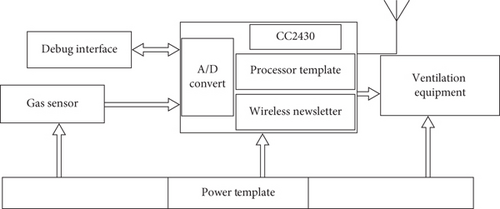
2.3.4. The Realization of Interior Art Design Color Matching
The most important thing in interior art design is the beauty of the design, so you should pay more attention to the color matching strategy. After long-term systematic research, several standard design types have been gradually formed for interior decoration.
For example, modern minimalist style, European pastoral style, Nordic light luxury style, and European pastoral style are generally similar to the Mediterranean decoration style. When using this decoration style for house decoration, the main color of the room is usually selected as blue. Blue will bring a fresher feel to the room. However, when using this decoration style for decoration, the main color of the decoration is not fixed. For example, pink, yellow, and blue are often used in the European pastoral style, but when choosing the brightness of the color, choose brighter but not too gorgeous colors; often white pigments are combined with the pigments used, so that the colors give people a lively and warm feeling on the senses.
The harmony of colors mainly refers to choosing a color as the main color of the room color in the process of designing the room. It also needs to be matched with the other colors, and based on this to improve the design sense and three-dimensional sense of the room. The perfect fusion of colors can make the overall color tone of the room look more comfortable and further improve the living experience of residents, so that residents can have a happy mood. “Indoor corner” is shown in Figure 6.
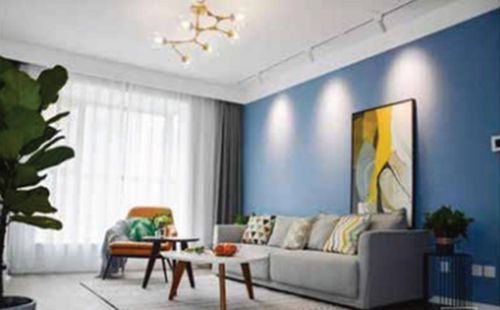
2.3.5. The Realization of Soft Decoration in Interior Design
Soft decoration materials are the structural decoration of the interior, which can beautify and decorate. Soft decoration is called the second decoration, which shows that the soft decoration is the progression of the first decoration, which is produced to strengthen the effect of the first decoration. Soft decoration has the characteristics of embellishment, beautification, movable, and detachable. The composition of soft decoration materials mainly includes decorative paintings, decorative ornaments, decorative flowers, curtains, sofas, etc. The combination of these items is used to optimize the space and achieve better interior artistic effect. The use of soft decorative materials requires comprehensive consideration of many factors. In the specific construction process, it is necessary to fully consider the indoor artistic effect and integrate the decoration style into it, so as to achieve the indoor decoration effect with artistic style. In addition, soft decorative materials can play a role in setting off the atmosphere. For example, through hanging paintings, decorations, etc., the artistic effect can be better highlighted. Since the soft decoration materials are easy to replace, in the process of use, the existing style can be changed by replacing the items to form a new interior art style. It can be seen that soft decorative materials play an important role in the creation of interior art.
In this paper, when designing the soft decoration, the principles of matching the soft decoration with the interior art style, maintaining the soft and hard coordination, and highlighting the key points in the application of soft decoration should be satisfied. Interior soft decoration design is shown in Figure 7.
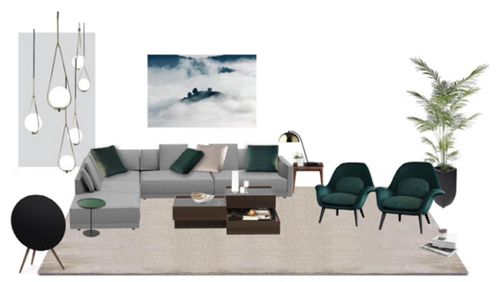
2.4. Interior Design Master Controller
The circuit design of the main controller consists of peripheral circuits, man-machine interface circuits, and interface circuits. The structure diagram is shown in Figure 8.
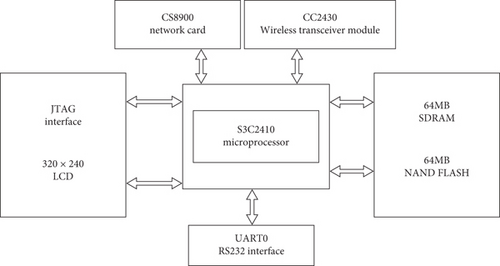
In a smart home, the external circuit is the basic circuit that realizes the work of the main controller, including the power supply circuit, the system reset circuit, and the memory circuit. The scheme uses FLASH and SDRAM two kinds of memory, uses 64 M NANDFLASH single-chip microcomputer K9F1208 as the FLASH memory, and uses two 16-bit SDRAM single-chip HY57V561620BT-H interfaces to form 32-bit SDRAM. The man-machine interface used by the system can easily realize the control and adjustment of the main controller, and the man-machine interface part used includes the test interface of liquid crystal display and JTAG. The LCD adopts a 3.5-inch TFT liquid crystal display with a touch screen, especially the TD035STEB2, with a resolution of 320 × 240.
2.4.1. Ethernet Interface Circuit
The main control system of the smart home adopts the ARM chip S3C2410 as the core. It does not have the connection method of Ethernet. In order to expand the connection of the network, CS8900A is used. CS8900A has two working modes: memory mode and IO mode. Using memory mode has the advantages of simple and easy to use, reading and writing, but the connection of its hardware is more complicated. The reading and writing of the IO method is complicated, but its hardware interface is relatively easy, and after the CS8900A is powered on or restarted, its default state is like this. The input and output methods are selected here. On this basis, the data bus, address bus, and control bus are used to realize the interconnection between the Ethernet network and the CPU. The first 16 bits (DATA[15 : 0]) of the S3C2410 are connected to SD[15 : 0] of CS8900A, because ADDR[19 : 0] of CS8900A is connected to SA[19 : 0] of Ethernet controller CS8900A. The processing speed of CS8900A is longer than that of S3C2410, and it can use nWAIT method to improve the access time. This scheme uses ADDR24 address line, that is, CS8900A’s read and write controller: nIOW and nIOR, and its specific lines are shown in Figure 9. The incoming signal will reach the CS8900A. RXD and RXD+ are differential receivers and differential transmission terminals on Ethernet.
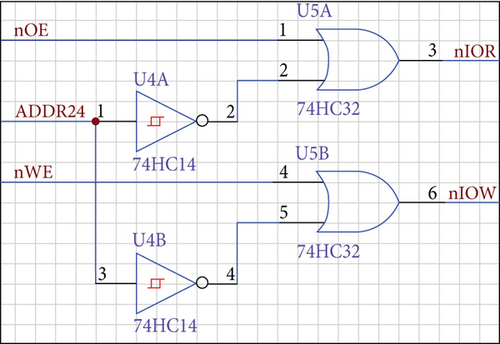
2.4.2. Wireless Transceiver Module Circuit
Radio transmit/receive transistor CC2430 has a full 8-bit port, while P2 has only 5 bits. All 21 IO pins are capable of responding to external disturbances and can interfere with IO port pins in the case of external devices and can use external disturbances to wake up sleep. In this scheme, serial communication technology is used between CC2430 and S3C2410 microcontroller. CC2430 and S3C2410 transmit serially to the input/output port P0.2 of CC2430 through the serial transmit port TXD1 and transmit to the serial receive port RXD1 of S3C2410 through P0.3, so that CC2430 and S3C2410 can communicate.
2.5. Structure of Embedded Operating System
Due to the limitation of the memory capacity and other resources of the embedded system, it is difficult to carry out in a development environment, so we adopt the host/object model when doing embedded development. A host is one that has more software. The target machine is a real embedded system applied to the system. A program compiled on the original platform that can run on a target platform with a different architecture is cross-compilation. The cross-compiled program cannot be executed on the original platform but can only be executed on the target platform. The compiler used to compile such a cross-platform program is a cross-compiler, so to generate a program that runs on the target computer, a cross-compilation environment must be established on the host computer. For this paper, we choose the Linux operating system, and the operating system installed on the host is Red Hat 9.0. The host computer needs to have standard serial port, Ethernet port, and parallel port in hardware, and the target computer’s boot program bootloader, Linux kernel, and file system are required in software. Linux uses GNU tools, and developers have compiled toolchains for common architectures that can be downloaded from the Internet. By compiling these tool chains, a cross-compilation environment can be established. This paper uses the cross-2.95.3.tar.bz2 package to establish a cross-compilation environment.
2.6. CGI Dynamic Interaction Technology
The CGI software is divided into two main parts: software and HTML. CGI can support Linux, Unix, Windows, etc., in many aspects and can be completed by different programming languages such as C, C++, and Perl. In embedded systems, Perl and other language are usually not used, and this kind of software also needs an auxiliary programs, which consume a lot of memory. C is the most common one, but C is less suitable for writing code like CGI because its code is very complex. However, there are already many open source C language libraries to support the development of CGI. This article chooses CGIC, which is an open-source C language that supports CGI. The latest CGIC code is 2.05, which can be found in the source code after compression.
2.7. Security Services of ZigBee Networks
In the ZigBee network architecture, the lowest two layers (PHY, MAC) use the IEEE 802.15.4 standard, and on top of them are the NWK and APL layers defined by the ZigBee Alliance. The PHY layer provides the most basic wireless communication capabilities; the MAC layer provides a single-hop, reliable link between devices; the NWK layer provides multihop, routing capabilities to build ZigBee networks with different topologies; the APL layer includes application support components. APS can provide services for ZDO and application, while APL provides application and ZDO key establishment, transmission, and device management services. The ZigBee security architecture uses the security services of IEEE 802.15.4, uses these security services to encrypt the transmitted data, and provides functions such as identity authentication and key management for devices accessing the network. ZigBee protocol provides security mechanism on three protocol layers of MAC, NWK, and APS, and each layer implements security protection for the frame of this layer. In addition, the APS layer is also responsible for the establishment and maintenance of the security relationship, and the ZDO layer is responsible for managing the security policy and security configuration of the device.
The MAC layer of ZigBee uses the algorithm of Advanced Encryption Mark (AES) for encryption. The algorithm uses a block of 128 bits as a parameter, and the key length is also selected as 128 bits. It is carried out according to the IEEE 802.15.4 protocol and ZigBee extension to ensure the confidentiality, consistency, and authenticity of the MAC layer frame. The MAC layer is responsible for its own security processing, but it is up to the upper layer to decide what security level it adopts. ZigBee provides a security solution based on 128-bit AES algorithm. Among them, CCM-128 and ICBC-MAC-128 support 128-bit grouping and key length.
3. Experiment Debugging
3.1. Endpoint Debugging
The software design of the terminal node adopts a modular design. Each function module is independent of each other, so when debugging, just download the binary file generated by the corresponding code to the corresponding terminal node. Take the temperature and humidity control node as an example to adjust the terminal node. The debugging process of the terminal node consists of three parts: program compilation, program programming, and result debugging.
3.1.1. Program Compilation
ZigBee’s protocol stack selects a simplified msstatePAN from Shenzhen Xu Ang Company. This protocol is based on the msstatePAN protocol stack developed by Professor Reese from the University of Mississippi and is formed by improving other codes such as the bottom layer of hardware. Before that, we wrote a control software for temperature and humidity control on the PC, temp-humi_control.h and temp-humi_control.h, and deleted the document containing the main function from the project.
3.1.2. Program Download
Use the USB interface to connect the development board to the PC, then open SmartRF04Prog.exe, select the directory of the rfd object in the Flashimage column, then turn on the power supply of the temperature and humidity control components, and then click the perform operation in SmartRF04Prog.exe to convert the rfd. The target file is put into the development board of the terminal.
3.1.3. Result Debugging
After the software is installed, the next thing to do is to test the terminal. The temperature and humidity control module is connected to the PC through a serial line, the power supply of the module is turned on, and the serial debugging auxiliary program is turned on, and the serial COM1, 57600 baud rate, parity bit NONE, data bit 8, and stop bit 1 are set and displayed on the PC, as shown in Figure 10.

3.2. Main Controller Debugging
Among them, the operation of the network server and the communication problem between S3C2410 and CC2430 need to be tested accordingly.
3.2.1. Boa Server Debug
The test method of Boa server is to use the FTP transfer protocol, transfer the main file/www file to/var through FlashFXP, and then put index.html into this folder. Start the console, open the game, type 192.168.0.115 on its address (to see the P, type ifconfig on the superstation), and then click the button to bring up the page.
3.2.2. Error Correction of Serial CGI Programming
S3C2410 and the CC2430 are combined in a serial manner. Compared with CC2430, the serial interface of S3C2410 just calls a serial function in Linux. Therefore, the key is to determine whether CGI programming can be adjusted, that is, programming in CGI format.
After the CGIC library is transplanted to the CGIC, the serial CGI programming test is carried out. After the migration of CGIC, you can use cgictesr.cgi to check the CGIC. The confirmation procedure is as follows: copy cgictest.cgi and capture to the/var/wwwcgi/bin/cgi-bin/directory, then enter a URL in the host’s reader: http://192.168.0.115/cgi-bin/http://cgitest.cgi.com/, and click enter to see the successful operation.
As far as interior art design itself is concerned, the application of BIM technology and ZigBee plays an important role and far-reaching significance in reducing costs, shortening design cycles, and design collaboration. Therefore, it is of practical significance to carry out in-depth research on the development of interior art design of BIM+ZigBee and expand the scope and scope of adaptation, which is of practical significance for the improvement of the level of interior art design.
The purpose of this paper is to complete the functions of the entire home intelligent monitoring and art design system. In the experiment, the software is used to test the performance of the entire system, and the coordination and monitoring terminals are, respectively, used as rooms to perform functions of each part of the PC detection. Using the interface-type air conditioner button, the temperature of the indoor air conditioner can be adjusted, and the lamp button can be used to adjust the brightness of the light bulb. At the same time, various parameters can be set according to personal preferences, and the computer can run automatically. Finally, through the experiment and analysis of the power consumption of each terminal monitoring network, the working life cycle of each node is obtained, which lays a foundation for the reduction of power consumption; all functional experiments are carried out indoors, including PC and mobile terminal functions to demonstrate the performance of the interior art design system of BIM + ZigBee.
4. Conclusion
- (1)
Through the comparison and analysis of various wireless technologies, ZigBee technology is selected to build a home intelligent wireless network; on this basis, an overall scheme and architecture of a home-based intelligent residence is proposed
- (2)
The environmental parameters such as temperature and humidity, illumination, air cleanliness, and viewing degree are analyzed in detail, and the specific structure of each node is proposed, and the control algorithm of temperature and humidity is discussed in depth, and the software is carried out. By adjusting indoor temperature and humidity, light, air cleanliness, and indoor art design viewing degree, the purpose of comfortable and ornamental living space is achieved, so that users can enjoy a comfortable living experience at any time
- (3)
The operating system is transplanted into the main controller, a web server is established, and the CGI technology is used to realize the remote monitoring of the home network, and the experiment is carried out
Conflicts of Interest
The authors declared that they have no conflicts of interest regarding this work.
Open Research
Data Availability
The datasets used in this paper are available from the corresponding author upon request.




